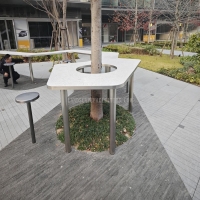Welcome to the website for landscape facilities products and knowledge.
How does the table’s design facilitate easy cleaning and stain resistance?
Contemporary table design has transformed maintenance from chore to effortless routine through intelligent engineering solutions. The foundation of easy cleaning begins with material selection—non-porous surfaces like quartz, sealed wood, and laminated composites create impermeable barriers that prevent liquid absorption. These materials eliminate the microscopic cavities where stains traditionally penetrate, allowing spills to remain on the surface where they can be easily wiped away.
Advanced protective coatings represent another crucial design element. Nano-scale sealants and ceramic-based finishes create invisible shields that repel common staining agents including coffee, wine, and oil-based substances. These coatings don't merely sit on the surface but bond molecularly with the base material, creating permanent protection that withstands repeated cleaning without degradation. The result is surface tension that causes liquids to bead up rather than spread, containing potential stains to manageable areas.
Edge construction plays an equally important role in cleanability. Modern tables increasingly feature seamless, waterfall edges or fully integrated corner joints that eliminate the cracks and crevices where dirt and moisture traditionally accumulate. This unified construction means cleaning requires a single wiping motion rather than meticulous scrubbing of hard-to-reach junctions. For tables with seams, manufacturers now use waterproof bonding agents that create perfect seals while maintaining visual continuity.
The integration of antimicrobial properties directly into table materials represents the latest innovation. Silver-ion infused surfaces and copper-alloy components actively inhibit bacterial growth between cleanings, reducing both maintenance frequency and hygiene concerns. This built-in protection works continuously without affecting the table's appearance or tactile qualities.
Maintenance considerations extend beneath the surface to structural elements. Many contemporary designs feature lifted bases with generous clearance for cleaning equipment, while others incorporate completely sealed undersides that prevent dust accumulation. These thoughtful details acknowledge that true cleanability encompasses the entire piece, not just the visible tabletop.
Through this multi-layered approach—combining advanced materials, protective coatings, seamless construction, and integrated antimicrobial properties—modern table design delivers unprecedented stain resistance and cleaning simplicity. The evolution represents not just improved functionality but a fundamental rethinking of how surfaces interact with their environment, transforming tables from high-maintenance furnishings into effortlessly maintained centerpieces.
Related search:

Recommendation
An outdoor bar counter with stainless steel and terrazzo materials in an irregular shape